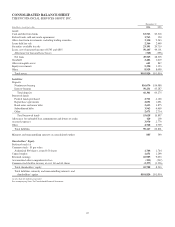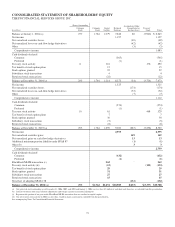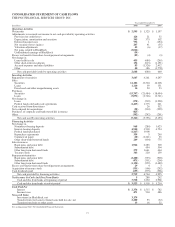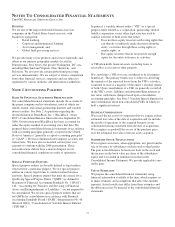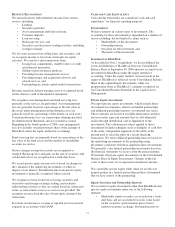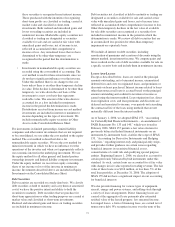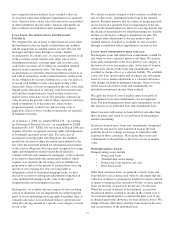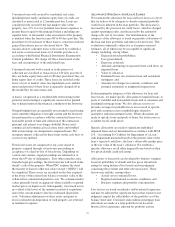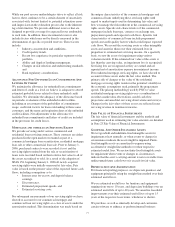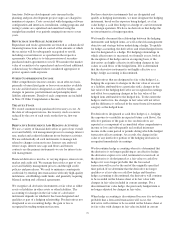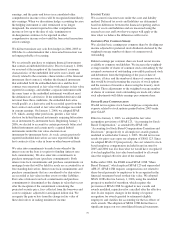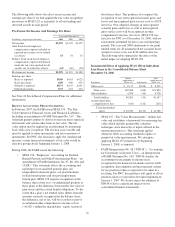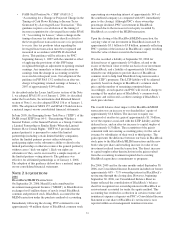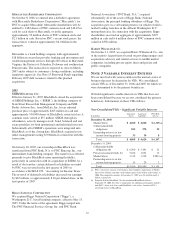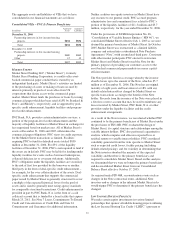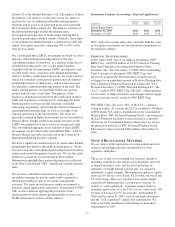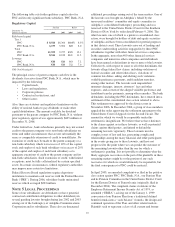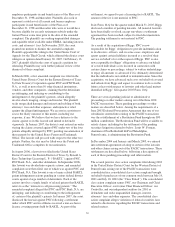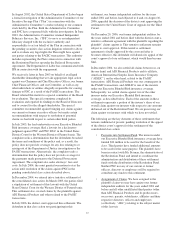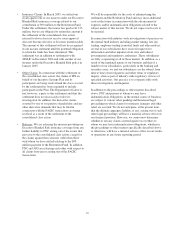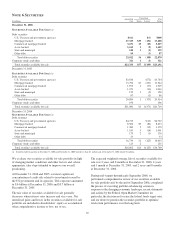PNC Bank 2006 Annual Report Download - page 89
Download and view the complete annual report
Please find page 89 of the 2006 PNC Bank annual report below. You can navigate through the pages in the report by either clicking on the pages listed below, or by using the keyword search tool below to find specific information within the annual report.earnings, and the gains and losses in accumulated other
comprehensive income or loss will be recognized immediately
into earnings. When we discontinue hedge accounting because
the hedging instrument is sold, terminated or no longer
designated, the amount reported in other comprehensive
income or loss up to the date of sale, termination or
de-designation continues to be reported in other
comprehensive income or loss until the forecasted transaction
affects earnings.
We did not terminate any cash flow hedges in 2006, 2005 or
2004 due to a determination that a forecasted transaction was
no longer probable of occurring.
We occasionally purchase or originate financial instruments
that contain an embedded derivative. Prior to January 1, 2006,
we assessed at the inception of the transaction if economic
characteristics of the embedded derivative were clearly and
closely related to the economic characteristics of the financial
instrument (host contract), whether the financial instrument
that embodied both the embedded derivative and the host
contract were measured at fair value with changes in fair value
reported in earnings, and whether a separate instrument with
the same terms as the embedded instrument would not meet
the definition of a derivative. If the embedded derivative did
not meet these three conditions, the embedded derivative
would qualify as a derivative and be recorded apart from the
host contract and carried at fair value with changes recorded
in current earnings. On January 1, 2006, we adopted SFAS
155, which, among other provisions, permits a fair value
election for hybrid financial instruments requiring bifurcation
on an instrument-by-instrument basis. Beginning January 1,
2006, we elected to account for certain previously bifurcated
hybrid instruments and certain newly acquired hybrid
instruments under this fair value election on an
instrument-by-instrument basis. As such, certain previously
reported embedded derivatives are now reported with their
host contracts at fair value in loans or other borrowed funds.
We enter into commitments to make loans whereby the
interest rate on the loan is set prior to funding (interest rate
lock commitments). We also enter into commitments to
purchase mortgage loans (purchase commitments). Both
interest rate lock commitments and purchase commitments on
mortgage loans that will be held for resale are accounted for as
free-standing derivatives. Interest rate lock commitments and
purchase commitments that are considered to be derivatives
are recorded at fair value in other assets or other liabilities.
Fair value of interest rate lock commitments and purchase
commitments is determined as the change in value that occurs
after the inception of the commitment considering the
projected security price, fees collected from the borrower and
costs to originate, adjusted for anticipated fallout risk. We
recognize the gain or loss from the change in fair value of
these derivatives in trading noninterest income.
I
NCOME
T
AXES
We account for income taxes under the asset and liability
method. Deferred tax assets and liabilities are determined
based on differences between the financial reporting and tax
bases of assets and liabilities and are measured using the
enacted tax rates and laws that we expect will apply at the
time when we believe the differences will reverse.
E
ARNINGS
P
ER
C
OMMON
S
HARE
We calculate basic earnings per common share by dividing net
income adjusted for preferred stock dividends declared by the
weighted-average number of shares of common stock
outstanding.
Diluted earnings per common share are based on net income
available to common stockholders. We increase the weighted-
average number of shares of common stock outstanding by the
assumed conversion of outstanding convertible preferred stock
and debentures from the beginning of the year or date of
issuance, if later, and the number of shares of common stock
that would be issued assuming the exercise of stock options
and the issuance of incentive shares using the treasury stock
method. These adjustments to the weighted-average number
of shares of common stock outstanding are made only when
such adjustments will dilute earnings per common share.
S
TOCK
-B
ASED
C
OMPENSATION
We did not recognize stock-based employee compensation
expense related to stock options granted before 2003 under
prior GAAP.
Effective January 1, 2003, we adopted the fair value
recognition provisions of SFAS 123, “Accounting for Stock-
Based Compensation,” as amended by SFAS 148,
“Accounting for Stock-Based Compensation-Transition and
Disclosure,” prospectively to all employee awards granted,
modified or settled after January 1, 2003. We did not restate
results for prior years upon our adoption of SFAS 123. Since
we adopted SFAS 123 prospectively, the cost related to stock-
based employee compensation included in net income for
2005 and 2004 was less than what we would have recognized
if we had applied the fair value based method to all awards
since the original effective date of the standard.
In December 2004, the FASB issued SFAS 123R “Share
Based Payment,” which replaced SFAS 123 and superseded
APB 25. SFAS 123R requires compensation cost related to
share-based payments to employees to be recognized in the
financial statements based on their fair value. We adopted
SFAS 123R effective January 1, 2006, using the modified
prospective method of transition, which requires the
provisions of SFAS 123R be applied to new awards and
awards modified, repurchased or cancelled after the effective
date. It also requires changes in the timing of expense
recognition for awards granted to retirement-eligible
employees and clarifies the accounting for the tax effects of
stock awards. The adoption of SFAS 123R did not have a
significant impact on our consolidated financial statements.
79


